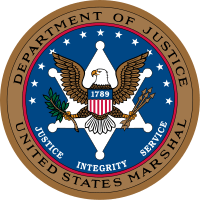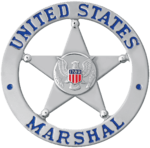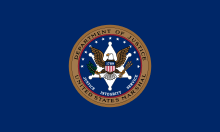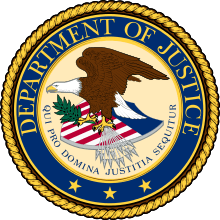United States Marshals Service
| United States Marshals Service | |
|---|---|
| Common name | U.S. Marshals |
| Abbreviation | USMS |
|
Variant flag of the U.S. Marshals Service | |
|
Seal of the U.S. Marshals Service | |
|
Badge of the U.S. Marshals Service | |
|
Flag of the U.S. Marshals Service | |
| Agency overview | |
| Formed | September 24, 1789 |
| Legal personality | Governmental: Government agency |
| Jurisdictional structure | |
| Federal agency | United States |
| Constituting instrument | United States Code, Title 28, Chapter 37[1] |
| General nature |
|
| Operational structure | |
| Headquarters | Arlington County, Virginia, U.S. |
| Sworn members | 94 U.S. Marshals, 3,953 Deputy U.S. Marshals and criminal investigators[2] |
| Agency executive | David Harlow, Deputy Director[3] |
| Parent agency | Department of Justice |
| Website | |
| usmarshals.gov | |
The United States Marshals Service (USMS) is a federal law enforcement agency within the U.S. Department of Justice (see 28 U.S.C. § 561). It is the oldest American federal law enforcement agency,[4] which was created by the Judiciary Act of 1789. The Marshals Service is attached to the Judicial branch of government, and is the enforcement arm of the federal courts. It is the primary agency for fugitive operations, responsible for prisoner transport, the protection of officers of the court, and for the effective operation of the judiciary. The Marshals Service operates the Witness Protection Program, and serves federal level arrest warrants.[5]
History
Origins
The office of United States Marshal was created by the First Congress. President George Washington signed the Judiciary Act into law on September 24, 1789.[6] The Act provided that the United States Marshal's primary function was to execute all lawful warrants issued to him under the authority of the United States. The law defined marshals as officers of the courts charged with assisting federal courts in their law-enforcement functions:
And be it further enacted, That a marshal shall be appointed in and for each district for a term of four years, but shall be removable from office at pleasure, whose duty it shall be to attend the district and circuit courts when sitting therein, and also the Supreme Court in the district in which that court shall sit. And to execute throughout the district, all lawful precepts directed to him, and issued under the authority of the United States, and he shall have the power to command all necessary assistance in the execution of his duty, and to appoint as shall be occasion, one or more deputies.[7]
The critical Supreme Court decision, affirming the legal authority of the federal marshals, was made in In re Neagle 135 U.S. 1 (1890).
For over 100 years marshals were patronage jobs, typically controlled by the district judge. They were paid primarily by fees until a salary system was set up in 1896.
Many of the first US Marshals had already proven themselves in military service during the American Revolution. Among the first marshals were John Adams's son-in-law Congressman William Stephens Smith for the District of New York, another New York district marshal, Congressman Thomas Morris, and Henry Dearborn for the district of Maine.
From the nation's earliest days, marshals were permitted to recruit special deputies as local hires, or as temporary transfers to the Marshals Service from other federal law-enforcement agencies. Marshals were also authorized to swear in a posse to assist with manhunts, and other duties, ad hoc. Marshals were given extensive authority to support the federal courts within their judicial districts, and to carry out all lawful orders issued by federal judges, Congress, or the President. Federal marshals were by far the most important government officials in territorial jurisdictions. Local law enforcement officials were often called "marshals" so there is often an ambiguity whether someone was a federal or a local official.
Federal marshals are most famous for their law enforcement work, but that was only a minor part of their workload. The largest part of the business was paper work—serving writs (e.g., subpoenas, summonses, warrants), and other process issued by the courts, made all the arrests, and handled all federal prisoners. They also disbursed funds as ordered by the courts. Marshals paid the fees and expenses of the court clerks, U.S. Attorneys, jurors, and witnesses. They rented the courtrooms and jail space, and hired the bailiffs, criers, and janitors. They made sure the prisoners were present, the jurors were available, and that the witnesses were on time.

The marshals thus provided local representation for the federal government within their districts. They took the national census every decade through 1870. They distributed presidential proclamations, collected a variety of statistical information on commerce and manufacturing, supplied the names of government employees for the national register, and performed other routine tasks needed for the central government to function effectively.
19th century enforcement roles, U.S. territory
During the settlement of the American Frontier, marshals served as the main source of day-to-day law enforcement in areas that had no local government of their own.[8] U.S. Marshals were instrumental in keeping law and order in the "Old West" era. They were involved in apprehending desperadoes such as Bill Doolin, Ned Christie, and, in 1893, the infamous Dalton Gang after a shoot-out that left Deputy Marshals Ham Hueston, Lafe Shadley, and posse member Dick Speed, dead. Individual deputy marshals have been seen as legendary heroes in the face of rampant lawlessness (see "Famous marshals", below) with Wyatt Earp, Bat Masterson, Dallas Stoudenmire, and Bass Reeves as examples of well-known marshals. Bill Tilghman, Heck Thomas, and Chris Madsen formed a legendary law enforcement trio known as "The Three Guardsmen" when they worked together policing the vast, lawless Oklahoma and Indian Territories.
The Fugitive Slave Act of 1850 tasked marshals to enforce the law, recover and arrest fugitive slaves. Any negligence in doing so exposed marshals and deputies to severe financial penalties.
On October 26, 1881, Deputy U.S. Marshal Virgil Earp, his brothers, Special Deputy U.S. Marshals Morgan and Wyatt Earp, and Special Deputy U.S. Marshal John "Doc" H. Holliday gunned down Frank and Tom McLaury and Billy Clanton in the legendary gunfight at the O.K. Corral in Tombstone, Arizona.
In 1894, U.S. Marshals helped suppress the Pullman Strike.
During the 1920s, they enforced Prohibition.
In modern times (20th century – present)
Marshals registered enemy aliens in wartime, sealed the American border against armed expeditions from foreign countries, and at times during the Cold War also swapped spies with the Soviet Union.
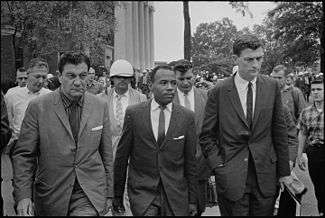
In the 1960s the marshals were on the front lines of the civil rights movement, mainly providing protection to volunteers. In September 1962, President John F. Kennedy ordered 127 marshals to accompany James Meredith, an African American who wished to register at the segregated University of Mississippi. Their presence on campus provoked riots at the university, but the marshals stood their ground, and Meredith registered. Marshals provided continuous protection to Meredith during his first year at Ole Miss, and Attorney General Robert F. Kennedy later proudly displayed a deputy marshal's dented helmet in his office. U.S. Marshals also protected black schoolchildren integrating public schools in the South. Artist Norman Rockwell's famous painting The Problem We All Live With depicted a tiny Ruby Bridges being escorted by four towering United States Marshals in 1964.
Until 1965, each U.S. District Court hired and administered it own marshals independently from all others. In 1965, the Executive Office for US Marshals, was created as "the first organization to supervise U.S. Marshals nationwide". The United States Marshals Service, a federal agency, was created in 1969[9][10]
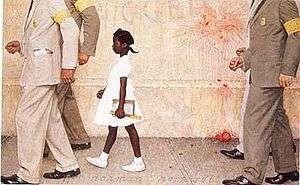
Since 1989, the Marshals Service has been responsible for law enforcement among U.S. personnel in Antarctica.[11] Marshals have protected American athletes at Olympic Games, the refugee boy Elián González before his return to Cuba in 2000, and abortion clinics as required by federal law. In 2003, Marshals retrieved North Carolina's copy of the Bill of Rights.[12]
Except for suits by incarcerated persons, non-prisoner litigants proceeding in forma pauperis, or (in some circumstances) by seamen, U.S. Marshals no longer serve process in private civil actions filed in the U.S. district courts. Under the Federal Rules of Civil Procedure, process may be served by any U.S. citizen over the age of 18 who is not a party involved in the case.
Duties
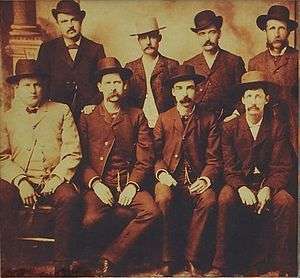
The Marshals Service is responsible for apprehending wanted fugitives, providing protection for the federal judiciary, transporting federal prisoners, protecting endangered federal witnesses, and managing assets seized from criminal enterprises. The Marshals Service is responsible for 55.2% of arrests of federal fugitives. Between 1981 and 1985, the Marshals Service conducted Fugitive Investigative Strike Team operations to jump-start fugitive capture in specific districts. In 2012, U.S. marshals captured over 36,000 federal fugitives and cleared over 39,000 fugitive warrants.[13]
The Marshals Service also executes all lawful writs, processes, and orders issued under the authority of the United States, and shall command all necessary assistance to execute its duties.
U.S. Marshals also have the common law-based power to enlist any willing civilians as deputies. In the Old West this was known as forming a posse, although under the Posse Comitatus Act, they cannot use troops for law enforcement duties while in uniform representing their unit, or the military service. However, if serviceman/woman is off duty, wearing civilian clothing, and willing to assist a law enforcement officer on his/her own behalf, it is acceptable.
Lastly, Title 28 USC Chapter 37 § 564. authorizes United States Marshals, deputy marshals and such other officials of the Service as may be designated by the Director, in executing the laws of the United States within a State, to exercise the same powers which a sheriff of the State may exercise in executing the laws thereof.[14]
Organization
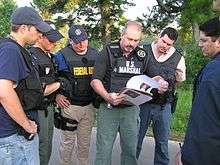

The Marshals Service is based in Arlington, Virginia, and, under the authority and direction of the Attorney General, is headed by a Director, who is assisted by a Deputy Director. The Marshals Service headquarters provides command, control, and cooperation for the disparate elements of the service.
Headquarters
- Director of the U.S. Marshals Service: David Harlow (acting)[15]
- Deputy Director of the U.S. Marshals Service
- Chief of Staff
- Equal Employment Opportunity (EEO)
- Financial Services Division (FSD)
- Office of Internal Communications (OIC)
- Office of General Counsel (OGC)
- Office of Professional Responsibility (OPR)
- Administration Directorate (ADA)
- Training Division (TD)
- Human Resources Division (HRD)
- Information Technology Division (ITD)
- Office of Public and Congressional Affairs
- Management Support Division (MSD)
- Asset Forfeiture Division (AFD)
- Operations Directorate (ADO)
- Judicial Security Division (JSD)
- Investigative Operations Division (IOD)
- Witness Security Division (WSD)
- Justice Prisoner and Alien Transportation System (JPATS)
- Tactical Operations Division (TOD)
- Special Operations Group (SOG)
- Prisoner Operations Division (POD)
- Deputy Director of the U.S. Marshals Service
Districts
The U.S. court system is divided into 94 federal judicial districts, each with a district court (except that the territory of Guam and the Commonwealth of the Northern Mariana Islands share a US Marshal), For each district there is a presidentially-appointed and Senate-confirmed United States marshal, a Chief Deputy U.S. Marshal (GS-14 or 15) (and an Assistant Chief Deputy U.S. Marshal (GS-14) in certain larger districts), Supervisory Deputy U.S. Marshals (GS-13),[16] and as many deputy U.S. Marshals (GS-7 and above)[16] and special deputy U.S. Marshals as needed. In the United States federal budget for 2005, funds for 3,067 deputy marshals and criminal investigators were provided. The U.S. Marshal for United States courts of appeals (the 13 circuit courts) is the U.S. Marshal in whose district that court is physically located.
The director and each United States Marshal are appointed by the President of the United States and subject to confirmation by the United States Senate. The District U.S. Marshal is traditionally appointed from a list of qualified law enforcement personnel for that district or state. Each state has at least one district, while several larger states have three or more.
Deputy U.S. Marshals
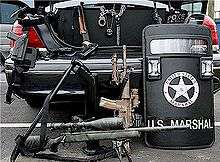
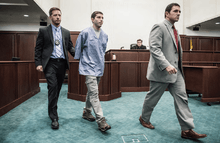


Training and job duties
Marshals Service hiring is competitive and comparable to the selection process for Special Agent positions in sister agencies. Typically fewer than five percent of qualified applicants are hired and must possess at a minimum a four-year bachelor degree or competitive work experience (which is usually three or more years at a local or state police department). While the USMS's hiring process is not entirely in the public domain, applicants must pass a written test, an oral board interview, an extensive background investigation, a medical examination and drug test, and multiple Fitness In Total (FIT) exams to be selected for training.[17]
Deputy U.S. Marshals complete a 21 1/2-week training program at the Federal Law Enforcement Training Center in Glynco, Georgia.
Deputy U.S. Marshals start their careers as 0082 basic Deputy U.S. Marshals at the GS-7 pay grade.[16] After the first year in grade, they are promoted to GS-9, the following year GS-11, and finally journeyman GS-12 (automatic progression to the grade of GS-13 is under consideration). Once deputies reach the GS-11 pay grade, they are reclassified as 1811 Criminal Investigators.[18] Criminal Investigators work additional hours and receive an additional 25% Law Enforcement Availability Pay on top of their base pay.
Deputies perform criminal investigations, execute warrants, and other investigative operations. They also protect government officials, process seized assets of crime rings for investigative agencies, and relocate and arrange new identities for federal witnesses in the United States Federal Witness Protection Program, which is headed by the USMS. After Congress passed the Adam Walsh Act, the U.S. Marshals Service was chosen to head the new federal sex offender tracking and prosecution hot team.
Titles
- Director of the United States Marshals Service: originally titled the Chief United States Marshal, top executive of the entire U.S. Marshals Service[16]
- United States Marshal: for the top executive Marshals Service position (political appointment) in a federal judicial district
- Chief Deputy United States Marshal: the senior career manager for the federal judicial district who is responsible for management of the Marshals office and staff
- Supervisory Deputy United States Marshal: for positions in the Marshals Service responsible for the supervision of three or more deputy U.S. Marshals and clerks
- Deputy United States Marshal: for all nonsupervisory positions classifiable to this series
Inspector
This title was created for promotions within the service usually for senior non-supervisory personnel. Senior Deputy U.S. Marshals (SrDUSM) assigned to the Witness Protection Program are given the title Inspector. Senior DUSMs assigned to regional fugitive task forces or working in special assignments requiring highly skilled criminal investigators often receive the title Inspector. Deputy marshals assigned to The Organized Crime Drug Enforcement (OCDETF) department within the USMS also hold the title of Senior Inspector. Inspectors receive a GS-13 pay grade level. The titles of Senior Inspector and Chief Inspector are also sometimes used in the service for certain assignments and positions within the agency.
Special Deputy U.S. Marshals
The Director, United States Marshals Service, is authorized to deputize the following persons to perform the functions of a Deputy U.S. Marshal in any district designated by the Director:
- (a) Selected officers or employees of the Department of Justice;
- (b) Selected federal, state, or local law enforcement officers whenever the law enforcement needs of the U.S. Marshals Service so require;
- (c) Selected employees of private security companies in providing courtroom security for the Federal judiciary;
- (d) Other persons designated by the Associate Attorney General pursuant to 28 CFR 0.19(a)(3).[19]
Court security officers
Court Security Officers (CSOs) are contracted former law enforcement officers who receive limited deputations as armed special deputy marshals and play a role in courthouse security.[20] Using security screening systems, Court Security Officers attempt to detect and intercept weapons and other prohibited items that individuals attempt to bring into federal courthouses. There are more than 4,700 Court Security Officers with certified law enforcement experience deployed at more than 400 federal court facilities in the United States and its territories.
Detention enforcement officer
DEOs (1802s) are responsible for the care of prisoners in USMS custody. They also are tasked with the responsibility of conducting administrative remedies for the U.S. Marshal. DEOs can be seen transporting, booking and securing federal prisoners while in USMS custody. They also provide courtroom safety and cell block security.
Detention enforcement officers are deputized and fully commissioned federal law enforcement officers by the U.S. marshal. They are authorized to carry firearms and conduct all official business on behalf of the agency. Not all districts employ detention enforcement officers.
Special Operations Group (SOG)
The Special Operations Group (SOG) was created in 1971, and is the Marshals Service specially trained and highly disciplined tactical unit. It is a self-supporting response team capable of responding to emergencies anywhere in the US or its territories. Most of the deputy marshals who have volunteered to be SOG members serve as full-time deputies in Marshals Service offices throughout the nation, and they remain on call 24 hours a day. The SOG also maintains a small, full-time operational cadre stationed at the Marshals Service Tactical Operations Center at Camp Beauregard, where all deputies undergo extensive, specialized training in tactics and weaponry.[21] Deputies must meet rigorous physical and mental standards. The group's missions include: apprehending fugitives, protecting dignitaries, providing court security, transporting high-profile and dangerous prisoners, providing witness security, and seizing assets. Members of the U.S. Marshal SOG Teams are armed with M1911A1 Springfield pro rail Pistol (.45 ACP). Marshals are also equipped with AR-15s and 12 gauge Remington 870 shotguns.
Firearms
The primary handgun for marshals is the Glock pistols in .40 S&W caliber (22, 23, 27), and each deputy may carry a backup handgun of their choice if it meets certain requirements.[22]
Line of duty deaths
More than 200 U.S. Marshals, deputy marshals, and special deputy marshals have been killed in the line of duty since Marshal Robert Forsyth was shot dead by an intended recipient of court papers in Augusta, Georgia, on January 11, 1794.[23] He was the first U.S. federal law enforcement officer to be killed in the line of duty.[24] The dead are remembered on an Honor Roll permanently displayed at Headquarters.
Scandals
On March 26, 2009, the body of Deputy U.S. Marshal Vincent Bustamante was discovered in Juarez, Mexico, according to the Marshals Service. Bustamante, who was accused of stealing and pawning government property, was a fugitive from the law at the time of his death. Chihuahua State Police said the body had multiple wounds to the head – apparently consistent with an execution-style shooting.[25]
In January 2007, Deputy U.S. Marshal John Thomas Ambrose was charged with theft of Justice Department property, disclosure of confidential information, and lying to federal agents during an investigation. Deputy Ambrose had been in charge of protecting mobster-turned-informant Nicholas Calabrese, who was instrumental in sending three mob bosses to prison for life.[26] A federal jury convicted Ambrose on April 27, 2009, of leaking secret government information concerning Calabrese to William Guide, a family friend and former Chicago police officer who had also served time in prison for corruption. Ambrose also was convicted of theft of government property but acquitted of lying to federal agents.[27] On October 27, 2009, Ambrose was sentenced to serve four years in prison.[28]
Racial discrimination
In 1998, retired Chief Deputy U.S. Marshal Matthew Fogg won a landmark EEO and Title VII racial discrimination and retaliation lawsuit against the Justice Department, for which he was awarded $4 million. The jury found the entire Marshals Service to be a "racially hostile environment" which discriminates against blacks in its promotion practices. U.S. District Judge Thomas Penfield Jackson summarized the jurors' decision by stating that they felt there was an "atmosphere of racial disharmony and mistrust within the United States Marshal Service".[29][30] As of 2011, Fogg is president of "Bigots with Badges",[30] and executive director of CARCLE (Congress Against Racism and Corruption in Law Enforcement), and is also associated with Law Enforcement Against Prohibition (LEAP), a drug law reform organization of law enforcement officers.[31]
Criticism
The Marshals Service played a critical role in Ruby Ridge. On August 21, 1992, six marshals were sent to scout the area to determine suitable places away from the cabin to arrest Randy Weaver. The marshals, dressed in camouflage, were equipped with night-vision goggles and M16 rifles.[32] Deputy Marshals Art Roderick, Larry Cooper and Bill Degan formed the reconnaissance team, while Deputy Marshals David Hunt, Joseph Thomas and Frank Norris formed an observation post team on the ridge north of the cabin.[33]
At one point, Roderick threw two rocks at the Weaver cabin to test the reaction of the dogs.The dogs became alerted, and Weaver's friend Kevin Harris, and Weaver's 14-year-old son, Samuel, emerged and followed the dog Striker to investigate. Harris and the younger Weaver were hoping that the dog had noticed a game animal since the cabin was out of meat. Sammy Weaver told his father he believed the dogs had sensed either a large animal or a man in the woods. The Recon team marshals (Roderick, Cooper and Degan) initially retreated through the woods in radio contact with the OP team, but later took up hidden defensive positions.
Later the OP team marshals and the Weavers both claimed the Weaver dogs were alerted to the Recon team marshals in the woods after neighbors at the foot of the mountain started their pickup truck. The Recon team marshals retreated through the woods to the "Y" juncture in the trails 500 yards west of the cabin, out of sight of the cabin. Sammy and Harris followed the dog Striker on foot through the woods while Randy also on foot took a separate logging trail. Vicki, Sara, Rachel, and baby Elisheba remained at the cabin, at first appearing anxious to the OP team, but later appearing relaxed. Randy encountered the marshals at the "Y"; Roderick claimed to have yelled, "Back off! U.S. Marshal!" upon sighting Weaver, and Cooper said he had shouted, "Stop! U.S. Marshal!" Later statements by Roderick, Cooper and Randy agreed that Randy responded by cursing and retreating from the marshals. About a minute later the dog and the boys came out of the woods and a firefight erupted between the marshals and Sammy and Harris.
Accounts differ at this point as to who first opened fire but agree that DUSM Roderick shot and killed Weaver's dog and that Samuel Weaver returned fire at Roderick.[34] After the Federal agents began firing, 14-year-old Samuel Weaver was shot in the back while retreating, and DUSM Degan was shot and killed by Harris.
An audit by the Office of Inspector General (OIG) (November 2010) of the Justice Department found "weaknesses in the USMS's efforts to secure federal court facilities in the six USMS district offices we visited".[35] The report found, among other things, that the Marshals Service's Judicial Security Division had contracted private security firms to provide Court Security Officers without having completed background checks. Another incident involved the Marshals Service awarding a $300 million contract to a firm that had a known history of numerous criminal activities leading to convictions for mail fraud and bank fraud and false insurance claims in addition to a civil judgment against its Chief Financial Officer. Technical problems included Court Security Officers not being properly trained on security screening equipment, which also meant equipment not being used. The OIG noted that in February 2009, several courthouses failed to detect mock explosives sent by Marshals Service Headquarters in order to test security procedures. They also found that eighteen percent of Court Security Officers had outdated firearms qualifications.
Notable marshals
- Jesse D. Bright (1812–1875), U.S. Marshal for Indiana; later served as U.S. senator for that state
- Seth Bullock (1849–1919), businessman, rancher, sheriff for Montana, sheriff of Deadwood, South Dakota, U.S. Marshal of South Dakota
- John F. Clark, U.S. Marshals Service Director and U.S. Marshal for the Eastern District of Virginia
- Charles Francis Colcord (1859–1934), rancher, businessman and marshal for Oklahoma
- Phoebe Couzins (1839–1913), lawyer, first woman appointed to the U.S. Marshals
- Henry Dearborn (1751–1829), marshal for the District of Maine
- Frederick Douglass (1818–1895), former slave and noted abolitionist leader, appointed U.S. Marshal for the District of Columbia in 1877
- Morgan Earp (1851–1882), Deputy U.S. Marshal, Tombstone, Arizona, appointed by his brother Wyatt
- Virgil Earp (1843–1905), Deputy U.S. Marshal, Tombstone, Arizona
- Wyatt Earp (1848–1929), Deputy U.S. Marshal (appointed to his brother Virgil Earp's place by the Arizona Territorial Governor)
- Frank Eaton (1860-1958), Deputy U.S. Marshal for Judge Isaac C. Parker, author, cowboy, scout, Indian fighter, and mascot for Oklahoma State University ("Pistol Pete")
- Richard Griffith (1814–1862), Brigadier General in the Confederacy during the Civil War
- Wild Bill Hickok (1837–1876), noted Western lawman, who served as a Deputy U.S. Marshal at Fort Riley, Kansas in 1867–1869
- Bass Reeves (July 1838 – January 1910) is thought by most to be one of the first Black men to receive a commission as a Deputy U.S. Marshal west of the Mississippi River. Before he retired from federal service in 1907, Reeves had arrested over 3,000 felons.
- Ward Hill Lamon (1826–1893), friend, law partner and frequent bodyguard of President Abraham Lincoln, who appointed him U.S. Marshal for the District of Columbia.
- J. J. McAlester (1842–1920), U. S. Marshal for Indian Territory (1893–1897), Confederate Army captain, merchant in and founder of McAlester, Oklahoma as well as the developer of the coal mining industry in eastern Oklahoma, one of three members of the first Oklahoma Corporation Commission (1907–1911) and the second Lieutenant Governor of Oklahoma (1911–1915).
- Benjamin McCulloch (1811–1862), U.S. Marshal for Eastern District of Texas; became a brigadier general in the army of the Confederate States during the American Civil War
- Henry Eustace McCulloch (1816–1895), U.S. Marshal for Eastern District of Texas. Brother of Benjamin McCulloch; also a Confederate General
- James J. P. McShane (1909–1968), Appointed U.S. Marshal for the District of Columbia by President John F. Kennedy then named chief marshal in 1962
- John W. Marshall, U.S. Marshal for the Eastern District of Virginia (1994–1999), first African-American to serve as Director of the U.S. Marshals Service (1999–2001)
- Bat Masterson (1853–1921), noted Western lawman; deputy to US marshal for Southern District of New York, appointed by Theodore Roosevelt
- Joseph Meek (1810–1875), territorial marshal for Oregon
- Thomas Morris (1771–1849), marshal for New York District.
- David Neagle, Shot former Chief Justice of California David S. Terry to protect US Supreme Court Justice Stephen Johnson Field resulting in US Supreme Court decision In re Neagle
- Henry Massey Rector (1816–1899), marshal for Arkansas, later governor of that state
- Porter Rockwell (c.1813–1878), deputy marshal for Utah
- William Stephens Smith (1755–1816), 1789 U.S. Marshal for New York district and son-in-law of President John Adams
- Dallas Stoudenmire (1845–1882), successful city marshal who tamed and controlled a remote, wild and violent town of El Paso, Texas; became U.S. Marshal serving West Texas and New Mexico Territory just before his death
- Heck Thomas (1850–1912), Bill Tilghman (1854–1924), and Chris Madsen (1851–1944), the legendarily fearless "Three Guardsmen" of the Oklahoma Territory
- Cal Whitson (1845-1926), one-eyed deputy marshal for the Oklahoma Territory. Rooster Cogburn of the novel and film True Grit is largely based on Whitson
- William F. Wheeler (1824–1894), marshal for the Montana Territory
- James E. Williams (1930–1999), marshal for South Carolina, Medal of Honor recipient
Fugitive programs
15 Most Wanted
The Marshals Service publicizes the names of wanted persons it places on the list of U.S. Marshals 15 Most Wanted Fugitives,[36] which is similar to and sometimes overlaps the FBI Ten Most Wanted Fugitives list or the Bureau of Alcohol, Tobacco, Firearms, and Explosives Most Wanted List, depending on jurisdiction.[37]
The 15 Most Wanted Fugitive Program was established in 1983 in an effort to prioritize the investigation and apprehension of high-profile offenders who are considered to be some of the country's most dangerous fugitives. These offenders tend to be career criminals with histories of violence or whose instant offense(s) pose a significant threat to public safety. Current and past fugitives in this program include murderers, sex offenders, major drug kingpins, organized crime figures, and individuals wanted for high-profile financial crimes.
Major cases
The Major Case Fugitive Program was established in 1985 in an effort to supplement the successful 15 Most Wanted Fugitive Program. Much like the 15 Most Wanted Fugitive Program, the Major Case Fugitive Program prioritizes the investigation and apprehension of high-profile offenders who are considered to be some of the country's most dangerous individuals. All escapes from custody are automatically elevated to Major Case status.[38]
Dirtbox use
The Wall Street Journal reported on 14 November 2014 that the Marshals Service's Technical Operations Group utilizes a so-called dirtbox to track fugitives.[39]
See also
References
- ↑ United States Code, Title 28, Chapter 37
- ↑ "Fact Sheet: United States Marshals Service" (PDF). usmarshals.gov. Retrieved 2011-06-17.
- ↑ "United States Marshals Service – Executive Management". Retrieved 2011-06-07.
- ↑ "United States Marshals Service Historical Timeline". United States Marshals Service. n.d.
- ↑ "United States Marshals Service". Gpo.gov. n.d. Retrieved 2014-07-27.
- ↑ "U.S. Marshals Celebrate 225 Years of Service". Department Of Justice. Retrieved 30 October 2014.
- ↑ "U.S. Marshals Service, History, Oldest Federal Law Enforcement Agency". Usmarshals.gov. 2004-06-03. Retrieved 2012-06-11.
- ↑ Larry D. Ball, The United States Marshals of New Mexico and Arizona Territories, 1846-1912 (1978).
- ↑ "Records of the United States Marshals Service". National Archives and Records Administration. Retrieved June 9, 2010. "Fact Sheets: General Information". usmarshals.gov. Retrieved 2010-06-26.
- ↑ "Marshals Service Organizational Chart". United States Department of Justice. August 13, 2007. Retrieved June 9, 2010.
- ↑ "U.S. Marshals make legal presence in Antarctica". United States Marshals Service. Retrieved January 8, 2007.
- ↑ "History in Custody: The U.S. Marshals Service Takes Possession of North Carolina's Copy of the Bill of Rights". United States Marshals Service. Retrieved January 8, 2007.
- ↑ "U.S. Marshals Service, 2013 Facts and Figures" (PDF). U.S. Marshals Service. Retrieved 22 April 2013.
- ↑ "28 USC Chapter 37 § 564.". Legal Information Institute. Cornell University. Retrieved March 26, 2011.
- ↑ (USMS), U.S. Marshals Service. "U.S. Marshals Service". www.usmarshals.gov. Retrieved 2016-01-09.
- 1 2 3 4 "Position classification standard for United States Marshal series, GS-0082" (PDF). United States Office of Personnel Management. June 1973.
- ↑ (USMS), U.S. Marshals Service. "U.S. Marshals Service". www.usmarshals.gov. Retrieved 2016-01-09.
- ↑ "Position Classification Standard for General Investigating/Criminal Investigating Series, GS-1810/1811" (PDF). United States Office of Personnel Management. Archived from the original (PDF) on March 27, 2009.
- ↑ 28 CFR 0.112 - Special deputation. | Title 28 - Judicial Administration | Code of Federal Regulations | LII / Legal Information Institute. Law.cornell.edu. Retrieved on 2013-10-30.
- ↑ "Court Security Officer position requirements". United States Marshals Service. Retrieved March 26, 2011.
- ↑ "US Marshals Service Special Operations Group". SpecWarnet. n.d. Retrieved 21 January 2015.
- ↑ "U.S. Marshals Service for Students: A Week in the Life of a Deputy U.S. Marshal: Wednesday". United States Marshals Service. Retrieved 22 February 2012.
- ↑ "Marshal Robert Forsyth". Officer Down Memorial Page. Retrieved March 26, 2011.
- ↑ "Constable Darius Quimby". Officer Down Memorial Page. Retrieved March 26, 2011.
- ↑ Gross, Doug (March 26, 2009). "Wanted U.S. marshal's body found in Mexico". CNN. Retrieved March 26, 2011.
- ↑ Robinson, Mike (April 13, 2009). "Deputy US Marshal John T. Ambrose To Be Tried For Leaking Secrets To The Mob". The Huffington Post. Retrieved March 26, 2011.
- ↑ Korecki, Natasha; Frank Main (April 28, 2009). "Deputy U.S. Marshal Ambrose guilty on two charges". Chicago Sun-Times. Archived from the original on May 2, 2009.
- ↑ "Trials". Chicago Tribune. Archived from the original on July 20, 2014.
- ↑ "Ramaea7.com". Web.archive.org. Archived from the original on July 20, 2010. Retrieved 2014-06-17.
- 1 2 "Congress Against Racism and Corruption in Law Enforcement".
- ↑ "Matthew F. Fogg". Retrieved March 26, 2011.
- ↑ Suprynowicz, Vin (1999). "The Courtesan Press, Eager Lapdogs to Tyranny (Chapter 6)". Send in the Waco Killers – Essays on the Freedom Movement, 1993–1998. Mountain Media. p. 288.
- ↑ DOJ OPR Ruby Ridge Task Force Report, 10 June 1994, p.112. (IV. Specific Issues Investigated D. Marshals Service Activities Between August 17 and August 21, 1992 2. Statement of Facts b. Shooting at the "Y" (d). The OP Team
- ↑ "Echoes of Ruby Ridge".
- ↑ "Audit of the United States Marshals Service's Oversight of its Judicial Facilities Security Program" (PDF). United States Department of Justice. November 2010. Retrieved March 26, 2011.
- ↑ "Current U.S. Marshals 15 Most Wanted Fugitives". United States Marshals Service. Retrieved March 26, 2011.
- ↑ ATF Online – Bureau of Alcohol, Tobacco and Firearms
- ↑ "Current U.S. Marshals Service Major Case Fugitives". United States Marshals Service. Retrieved March 26, 2011.
- ↑ Barrett, Devlin (13 November 2014). "Americans' Cellphones Targeted in Secret U.S. Spy Program". The Wall Street Journal. Retrieved 14 November 2014.
Further reading
- Ball, Larry D. The United States Marshals of New Mexico and Arizona Territories, 1846-1912 (1978).
- Ball, Larry D. "'Just And Right In Every Particular': US Marshal Zan Tidball and the Politics of Frontier Law Enforcement." Journal of Arizona History 34.2 (1993): 177-200.
- Calhoun, Frederick S., and US Dept of Justice. The Lawmen: United States Marshals and their Deputies (Smithsonian Press, 1989). online
- Ellis, Mark R. Law and order in Buffalo Bill's country: legal culture and community on the Great Plains, 1867-1910 (U of Nebraska Press, 2007).
- Gomez, Laura E. "Race, colonialism, and criminal law: Mexicans and the American criminal justice system in territorial New Mexico." Law and Society Review (2000): 1129-1202.
- Lamar, Howard R. The New Encyclopedia of the American West (1998) p 678-79.
External links
| Wikimedia Commons has media related to United States Marshals Service. |
- Official website
- Court Security Program – includes role in CSOs
- Authority of FBI agents, serving as special deputy United States marshals, to pursue non-federal fugitives
- Deputization of Members of Congress as special deputy U.S. marshals
- USC on the U.S. Marshals Service
- Retired US Marshals Association
- U.S. Diplomatic Security Service (DSS)
- Stacia Hylton Director of U.S. Marshals Service
.svg.png)
